Vang Thi Thong, 31, needs only look for red buds on the old tree in her mother’s village to know when to plant her rice seedlings.
|
|
| TO THE BRIM: The terraced fields are drenched in water prior to the new rice planting season. VNS Photo Bui Dieu Minh |
“The tree tells us when to start planting rice. When the first red buds show, we start to sow seeds, when the buds all turn green, it’s time to transplant them in the watered fields, and when all the leaves start to fall, it’s time to harvest, which we do until there are no leaves left,” Thong said of her village’s farming schedule, which all depends on the changes of an ancient tree.
“If the red buds are yet to appear and you sow rice seeds, your rice will probably be damaged by worms and insects. This method has been followed since the days of our great-great-grandparents.”
"Mẩy coóng is what the Tay ethnic minority people in Bac Ha call this giant wild tree, whose seeds can also be used to wash your hair. It’s a natural soap,” said Nguyen Huy Trung, who owns a tour business and leads a network of young homestay owners in the area.
“The tree isn’t far away, only a few hundred metres.”
What first seemed to be so close, though, turned out to be 2-km walk downhill along a dusty rocky road, which meant the same walk uphill at the end of the day, when we’re exhausted from having walked nearly 10km since the morning.
Horse race on track
In the mountains of Bac Ha, where rough roads make travel difficult for the local Mông people, who make up 47 per cent of the district’s population, using horses to ferry goods has been common for centuries.
Bac Ha, the district, has been dubbed "The White Highlands" due to the massive white plum flowers that blossom during spring.
The mountainous district is home to more than 60,000 people of the Mông, Tày, Black Dao, and other groups inhabiting 683sq.km.
Located on an elevated plain between 1,000 and 1,500m above sea level, the slopes of lime-karst mountains in the district angle up at between 24 and 28 degrees. The district boasts a mild average annual temperature of 25 degrees Celsius.
Every year the district’s traditional horse racing event brings together dozens of horses from the district and neighbouring Si Ma Cai District. It has become a much-anticipated event, with tourists coming from as far away as Hanoi and other cities on the plains.
“We hope to make the race an event that will bring in local tourists once again,” said Hoang Van Khoa, deputy chairman of the Bac Ha District’s People’s Committee.
“With Tet [Lunar New Year] and then the COVID-19 pandemic, people have had to stay at home for nearly six months.
“Many Vietnamese used to travel abroad and spend a lot of money. If we can provide an interesting attraction with good quality services, then we hope they will come to a local destination like Bac Ha.
"Vietnam has a population of nearly 100 million, and if we can tap into that market it would be a major driving force for tourism.”
He added that under the existing circumstances it’s possible that borders won’t reopen until the end of the year.
“In our agenda proposal for the upcoming district Party Committee Congress, which was scheduled to take place on June 10 and 11, we noted that during the future committee’s term of 2020-2025 we would mobilise everyone to empower community-based tourism,” Khoa said.
“First we hope to start with our communes, which already have some families offering homestay services, and we’ve put it on paper that we want the number of households offering homestays to reach 10 per cent in each community.”
 |
| OFF & RUNNING: The annual Bac Ha Open Horse Race attracted nearly 30,000 spectators to the town’s stadium on the last weekend of May. VNS Photo Viet Thanh |
Community-based tourism
At a relative’s wooden stilt house, Thong talked about her family’s attitude towards community-based tourism.
“We had a few meetings in our village, where officials from the Centre for Rural Economy Development came to talk to us about it,” she said, her tanned face smiling.
“We began to build new bathrooms in our house last year. Our parents built our wooden stilt house in 2009, and it’s a long way from the humble hut they started out with, which was just three metres wide. They have rebuilt the house three times already — each time bigger and stronger than before.
“We live in a remote village far from major city centres and we have many limitations, and really need help from tourism.”
Her homestay’s new facilities were completed just after Tet, last February, but then the coronavirus made it impossible for her to welcome visitors.
“They have been waiting to host visitors for so long,” said Thai Thi Huyen Nga, programme officer with the Centre for Rural Economy Development, who makes weekly visits to Bac Ha to train homestay hosts on hygiene, cooking and other tourism matters. “You’ll be made to feel most welcome.”
In a small village of the Tày, two families live just five minutes away from each other but neither have a phone. If you want to arrange a meeting with them, you have to message Lam A Nang, a homestay host with a day job working for Electricity of Vietnam. He’s the link for any questions about the family’s terraced fields, tea buds, or horses and cattle.
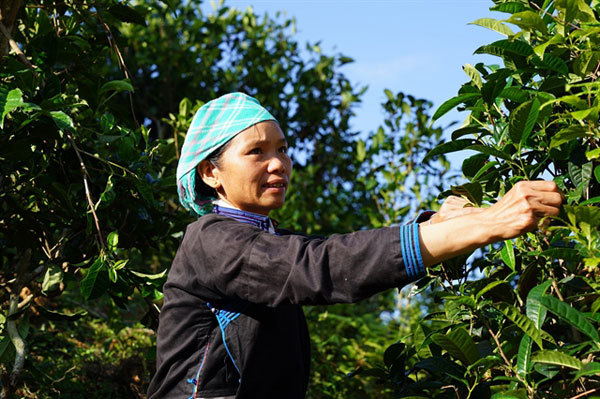 |
| WORKING DAY: Vang Thi Can picks tea buds at her family’s plantation, which are sent to a processing centre nearby. She does all the work on the plantation. VNS Photo Bui Dieu Minh |
“We sow 80 kilos of rice seed each year,” his wife Vang Thi Can told us.
With two households ready to welcome guests, Nga thoughtfully arranged for our group to be divided in two.
“We understand that community-based tourism means that not just one single family hosts visitors and reaps all the benefits,” Thong said.
“The whole community is involved. You might have a community arts troupe or some families providing food for the homestay families or offering something else.
“It’s quite hard for us, because during the day we must still take care of our farms or our crops will suffer. We only need to grow enough to eat during the year. The money we earn from selling tea buds goes into buying maize and rice seeds for the next crop, and on it goes.”
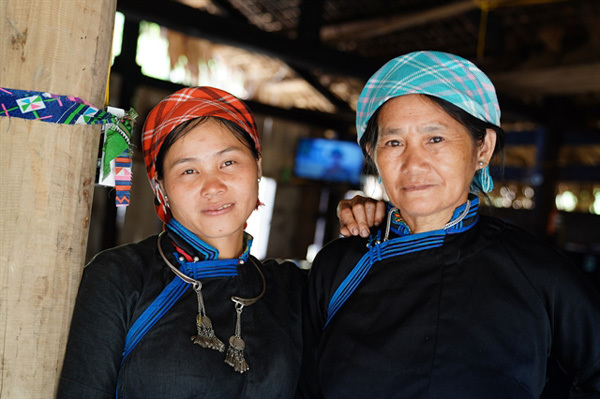 |
| IN IT TOGETHER: Vang Thi Thong (left) and her mother-in-law, with whom she entrusts her four-year-old son on the family farm and homestay. VNS Photo Bui Dieu Minh |
In their early 30s, Thong and her husband Lam A Ha’s beautiful wooden stilt house has a thatched roof and can cater to 11 guests each night.
They sow four kilos of rice seed a year — significantly less than their relatives — but they also tend to the tea and cinnamon farms, some cattle, several pigs, and 20-plus ducks.
“We work hard every day,” Thong said. “I grew up in a family with my mother and five sisters. My father died when I was just a year old. My mother grew only enough rice for us for three months of the year, so she had to work odd jobs and travel far away.”
The youngest in her family, Thong completed high school and studied English for a year at school. “I was married at 23 - quite late for a girl in my community - and had my first child at 24,” she said.
Thong and her husband are still thinking of a name for their homestay.
“We did all the rearranging around the house in the evening after dinner,” she explained. “I’m fortunate to have kind-hearted parents-in-law. They have treated me well and have never said anything harsh to me.”
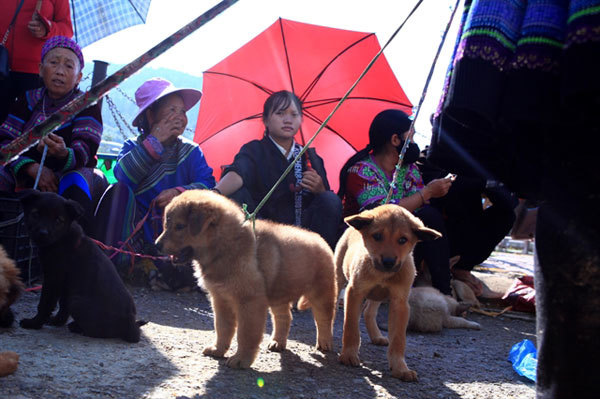 |
| BUY & SELL: Bac Ha Market Fair is the local venue for livestock trading, including cattle, buffaloes, and horses, with a pet fair for dogs and poultry and a vibrant tapestry market where you can find colourful scarves, indigo clothing, and yarn of myriad colours. VNS Photo Viet Thanh |
New skills preserve old traditions
During our meeting in his office, Deputy Chairman Khoa said he hopes that when visitors arrive it will encourage local people to preserve their local traditions. “We hope that people will make every effort to keep their traditional values intact after they interact with visitors from the outside world,” he said.
Khoa took over his position just 20 days before the horse race was to take place, but has worked in Bac Ha District for many years. While he has visited many places in the northern mountains, he still sees that Bac Ha Market is the focal point for tourists.
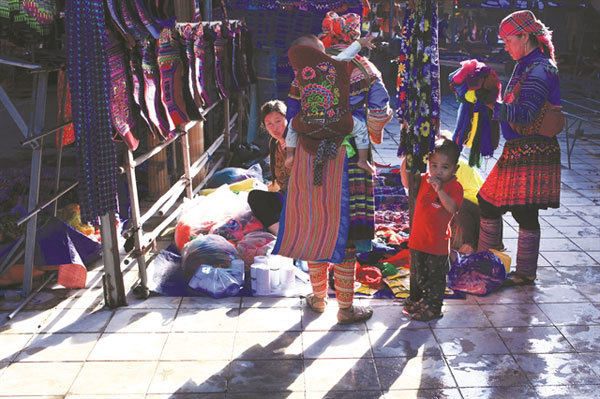 |
| BARGAINS: Shoppers in the colourful tapestry section at Bac Ha Sunday Market. VNS Photo Viet Thanh |
After hosting this first group of visitors, Thong said she and her husband will have to talk with his grandparents before they can go to the commune office to study English.
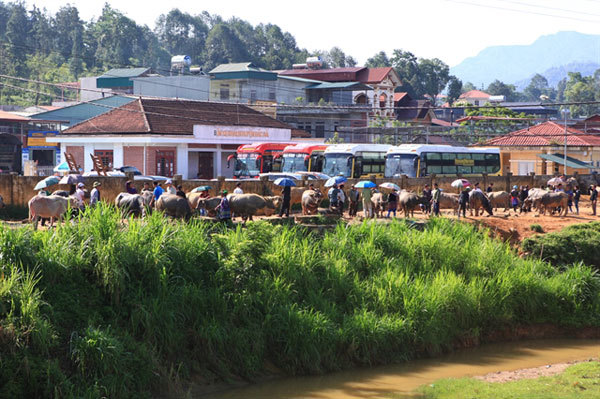 |
| TRADING PLACES: Water buffalo for sale at the Bac Ha Sunday Market. VNS Photo Viet Thanh |
“We need to get their help, because if they agree to take care of our four-year-old son then either my husband or I could go to English classes,” she said.
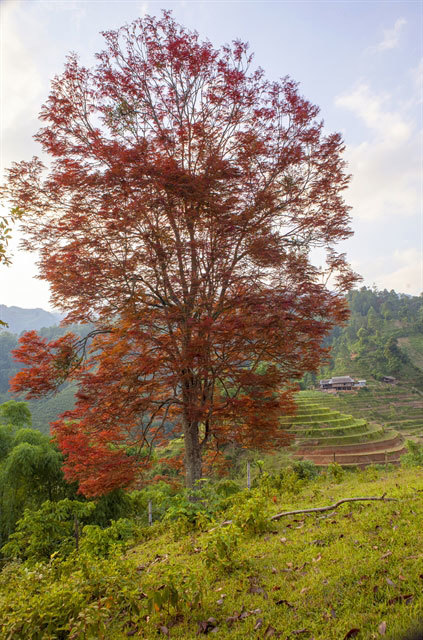 |
“I’m thinking of planting a mẩy coóng tree here in front of our house,” her husband said. “The tree would be a landmark for our house. It’s beautiful and it tells us when to plant our rice crop.”
Perhaps in a few years a new homestay called "Mẩy coóng" will be added to the list of accommodation options amid the beautiful terraced fields of Bac Ha, with its deep red foliage providing a stunning backdrop for those who visit. VNS
Nguyen My Ha

Children carried by mothers at Bac Ha Market
It is common to see little children carried on their mother backs at Bac Ha Market in the northern mountainous province of Lao Cai.

Stunning beauty of Bac Ha as seen from above
Bac Ha is a northeastern district in Lao Cai province. The wonderful natural beauty and extraordinary culture turn Bac Ha district into an attractive destination for tourists.
 It’s the watering season for the terraced fields in the mountains of Bac Ha District in the northern province of Lao Cai.
It’s the watering season for the terraced fields in the mountains of Bac Ha District in the northern province of Lao Cai. 